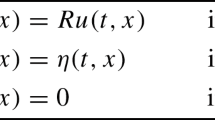Abstract
Parametric nonlinear control problems subject to vector-valued mixed control-state constraints are investigated. The model perturbations are implemented by a parameter p of a Banach-space P. We prove solution differentiability in the sense that the optimal solution and the associated adjoint multiplier function are differentiable functions of the parameter. The main assumptions for solution differentiability are composed by regularity conditions and recently developed second-order sufficient conditions (SSC). The analysis generalizes the approach in [16, 20] and establishes a link between (1) shooting techniques for solving the associated boundary value problem (BVP) and (2) SSC. We shall make use of sensitivity results from finite-dimensional parametric programming and exploit the relationships between the variational system associated to BVP and its corresponding Riccati equation.
Solution differentiability is the theoretical backbone for any numerical sensitivity analysis. A numerical example with a vector-valued control is presented that illustrates sensitivity analysis in detail.
Similar content being viewed by others
References
H.G.Bock, “Zur numerischen Behandlung zustandsbeschränkter Steuerungsprobleme mit Mehrzielmethode und Homotopieverfahren,” ZAMM, vol. 57, pp. 266–268, 1990.
H.G.Bock and P.Krämer-Eis, “An efficient algorithm for approximate computation of feedback control laws in nonlinear processes,” ZAMM, vol. 61, pp. 330–332, 1981.
R. Bulirsch, “Die Mehrzielmethode zur numerischen Lösung von nichtlinearen Randwertproblemen und Aufgaben der optimalen Steuerung,” Report of the Carl-Cranz Gesellschaft, Oberpfaffenhofen, 1971.
D.J.Clements and B.D.O.Anderson, Singular optimal control: The linear-quadratic problem, Lecture Notes in Control and Information Sciences, vol. 5, Springer-Verlag: Berlin, 1978.
A.L.Dontchev and W.W.Hager, “Lipschitz stability in nonlinear control and optimization,” SIAM J. Control and Optimization, vol. 31, pp. 569–603, 1993.
A.L.Dontchev, W.W.Hager, A.B.Poore, and B.Yang, “Optimality, stability and convergence in nonlinear control,” Applied Math. Optim., vol. 31, pp. 569–603, 1995.
A.V.Fiacco, Introduction to Sensitivity and Stability Analysis in Nonlinear Programming, Academic Press: New York, 1983.
W.W.Hager, “Lipschitz continuity for constrained processes,” SIAM J. Control and Optimization, vol. 17, pp. 321–336, 1979.
E.V.Haynsworth, “Determination of the inertia of a partitioned Hermitian matrix,” Linear Algebra and Applications, vol. 1, pp. 73–81, 1968.
K.Ito and K.Kunisch, “Sensitivity analysis of solutions to optimization problems in Hilbert spaces with applications to optimal control and estimation,” Journal of Differential Equations, vol. 99, pp. 1–40, 1992.
P. Krämer-Eis, “Ein Mehrzielverfahren zur numerischen Berechnung optimaler Feedback-Steuerungen bei beschränkten nichtlinearen Steuerungsproblemen,” Bonner Mathematische Schriften, vol. 164, 1985.
B.Kugelmann and H.J.Pesch, “A new general guidance method in constrained optimal control, Part 1: Numerical method,” J. Optim. Theory and Appl., vol. 67, pp. 421–435, 1990.
B.Kugelmann and H.J.Pesch, “A new general guidance method in constrained optimal control, Part 2: Application to space shuttle guidance,” J. Optim. Theory and Appl., vol. 67, pp. 437–446, 1990.
K.Malanowski, “Sensitivity analysis of optimization problems in Hilbert space with application to optimal control,” Appl. Math. Optim., vol. 21, pp. 1–20, 1990.
K.Malanowski, “Second order conditions and constraint qualifications in stability and sensitivity analysis of solutions to optimization problems in Hilbert spaces,” Applied Math. Optim., vol. 25, pp. 51–79, 1992.
K.Malanowski, “Two-norm approach in stability and sensitivity analysis of optimization and optimal control problems,” Advances in Math. Sciences and Applications, vol. 2, pp. 397–443, 1993.
K.Malanowski, “Stability and sensitivity of solutions to nonlinear optimal control problems.” Appl. Math. Optim., vol. 32, pp. 111–141, 1994.
K.Malanowski, “Regularity of solutions in stability analysis of optimization and optimal control problems,” Control and Cybernetics, vol. 23, pp. 61–86, 1994.
H.Maurer and H.J.Pesch, “Solution differentiability for parametric nonlinear control problems,” SIAM Journal on Control and Optimization, vol. 32, pp. 1542–1554, 1994.
H.Maurer and H.J.Pesch, “Solution differentiability for parametric nonlinear control problems with control-state constraints,” Control and Cybernetics, vol. 23, pp. 201–227, 1994.
H.Maurer and S.Pickenhain, “Second order sufficient conditions for optimal control problems with mixed control-state constraints,” Journal of Optimization Theory and Applications, vol. 86, pp. 649–667, 1995.
L.W.Neustadt, Optimization: A Theory of Necessary Conditions, Princeton University Press: Princeton, 1976.
H.J.Oberle and W.Grimm, “BNDSCO—A program for the numerical solution of optimal control problems,” Institute for Flight Systems Dynamics, DLR, Oberpfaffenhofen, Germany, Internal Report No. 515–89/22, 1989.
H.J.Pesch, “Real-time computation of feedback controls for constrained optimal control problems, Part 1: Neighbouring extremals,” Optimal Control Applications & Methods, vol. 10, pp. 129–145, 1989.
H.J.Pesch, “Real-time computation of feedback controls for constrained optimal control problems, Part 2: A correction method based on multiple shooting,” Optimal Control Applications & Methods, vol. 10, pp. 147–171, 1989.
S.Pickenhain, “Sufficiency conditions for weak local minima in multidimensional optimal control problems with mixed control-state restrictions,” Zeitschrift für Analysis und ihre Anwendungen, vol. 11, pp. 559–568, 1992.
W.T.Reid, Riccati Differential Equations, Mathematics in Science and Engineering, vol. 86, Academic Press: New York, 1972.
S.M.Robinson, “Local structure of feasible sets in nonlinear programming, Part III: Stability and sensitivity,” Mathematical Programming Study, vol. 30, pp. 45–66, 1987.
V.Zeidan, “The Riccati equation for optimal control problems with mixed state-control constraints: Necessity and sufficiency,” SIAM J. Control and Optimization, vol. 32, pp. 1297–1321, 1994.
Author information
Authors and Affiliations
Rights and permissions
About this article
Cite this article
Malanowski, K., Maurer, H. Sensitivity analysis for parametric control problems with control-state constraints. Comput Optim Applic 5, 253–283 (1996). https://doi.org/10.1007/BF00248267
Received:
Revised:
Issue Date:
DOI: https://doi.org/10.1007/BF00248267




